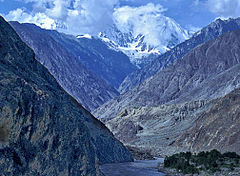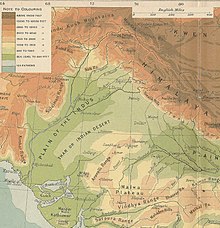
Back Indus Afrikaans Indus ALS ኢንዱስ ወንዝ Amharic Río Indo AN Indus ANG نهر السند Arabic واد سند ARY نهر السند ARZ সিন্ধু নদী Assamese Ríu Indo AST
| Indus Sindh / Sindhu / Mehran[1] | |
|---|---|
 The Indus Gorge is formed as the Indus River bends around the Nanga Parbat massif, shown towering behind, defining the western anchor of the Himalayan mountain range. | |
 The course and major tributaries of the Indus river | |
| Location | |
| Country | China, India, Pakistan Sovereignty in the Kashmir region is disputed |
| States and Provinces | Tibet Autonomous Region, Ladakh, Gilgit-Baltistan, Khyber Pakhtunkhwa, Punjab, and Sindh, |
| Cities | Leh, Skardu, Dasu, Besham, Thakot, Swabi, Dera Ismail Khan, Bhakkar, Sukkur, Hyderabad, Karachi |
| Physical characteristics | |
| Source | Lake Manasarovar[2] |
| - location | Tibetan Plateau |
| Source confluence | |
| - location | Shiquanhe, Ngari Prefecture, Tibet Autonomous Region, People's Republic of China |
| - coordinates | 32°29′54″N 79°41′28″E / 32.49833°N 79.69111°E |
| - elevation | 4,255 m (13,960 ft) |
| Mouth | Arabian Sea (primary), Rann of Kutch (secondary) |
| - location | Indus River Delta (primary), Kori Creek (secondary), Pakistan, India |
| - coordinates | 23°59′40″N 67°25′51″E / 23.99444°N 67.43083°E |
| - elevation | 0 m (0 ft) |
| Length | 3,180 km (1,980 mi) as Mapped. 3,249 km (2,019 mi) actual as mentioned in History Books. |
| Basin size | 1,165,000 km2 (450,000 sq mi) 1,081,718 km2 (417,654 sq mi)[3] |
| Discharge | |
| - location | Indus Delta, Arabian Sea, Pakistan |
| - average | 5,533 m3/s (195,400 cu ft/s)[3] |
| - minimum | 1,200 m3/s (42,000 cu ft/s) |
| - maximum | 58,000 m3/s (2,000,000 cu ft/s) |
| Discharge | |
| - location | Sukkur |
| - average | 5,673.486 m3/s (200,357.3 cu ft/s)[4] |
| Discharge | |
| - location | Mithankot |
| - average | 5,812.326 m3/s (205,260.4 cu ft/s)[4] |
| Discharge | |
| - location | Tarbela Dam |
| - average | 2,469 m3/s (87,200 cu ft/s) |
| Basin features | |
| Tributaries | |
| - left | Zanskar River, Suru River, Soan River, Panjnad River, Ghaggar-Hakra River, Luni River |
| - right | Shyok River, Hunza River, Gilgit River, Swat River, Kunar River, Kabul River, Kurram River, Gomal River, Zhob River |

The Indus River (Urdu: دریائے سندھ) is the greatest river on the western side of the subcontinent. It was the birthplace of the bronze age Indus Valley civilization and the Gandhara civilization. Indus river is the national and the longest river in Pakistan.[5] It flows through Tibet, Ladakh and throughout Pakistan. It is one of the main rivers of the Indo-Gangetic Plain.
The river is 3180 km long. It is Pakistan's longest river. The river has a total drainage area exceeding 1,165,000 km2 (450,000 sq mi). Its estimated annual flow stands at around 207 km3 (50 cu mi), making it the twenty-first largest river in the world in terms of annual flow. It discharges about 6,600 cubic meters per second.
The word Indus and the related word "Hindu" are derived from the Sanskrit word Sindhu.[6] The Ancient Greeks used the word Indós; Hinduš was Old Persian; Sindhu in Sindhi and Sanskrit. Latest languages on the sub-continent use either Sindh (modern Sindhi) or Sindhu or very similar words. The name of India and Indonesia are both derived from the Indus river of Pakistan.[7]
- ↑ Ahmad, Nafis; Lodrick, Deryck (6 February 2019). "Indus River". Encyclopedia Britannica. Retrieved 5 February 2021.
- ↑ Ahmad, Ijaz; Zhang, Fan; Tayyab, Muhammad; Anjum, Muhammad Naveed; Zaman, Muhammad; Liu, Junguo; Farid, Hafiz Umar; Saddique, Qaisar (2018-11-15). "Spatiotemporal analysis of precipitation variability in annual, seasonal and extreme values over upper Indus River basin". Atmospheric Research. 213: 346–60. Bibcode:2018AtmRe.213..346A. doi:10.1016/j.atmosres.2018.06.019. ISSN 0169-8095. S2CID 125980503.
- ↑ 3.0 3.1 Amir, Khan; Naresh, Pant; Anuj, Goswami; Ravish, Lal; Rajesh, Joshi (Dec 2015). "Critical Evaluation and Assessment of Average Annual Precipitation in The Indus, The Ganges and The Brahmaputra Basins, Northern India - Himalayan Cryospheric Observations and Modelling (HiCOM)".
- ↑ 4.0 4.1 "Rivers Network". 2020. Archived from the original on 2022-06-29. Retrieved 2022-07-31.
- ↑ usman (2023-01-26). "What are the Six Rivers in Pakistan?". Noon Academy. Retrieved 2023-12-01.[permanent dead link]
- ↑ "Cognate" means descended from a common ancestor, of the same family, coming from the same stock or root. Shorter Oxford English Dictionary, vol 1, p337.
- ↑ Shorter Oxford English Dictionary vol 2, p989.
© MMXXIII Rich X Search. We shall prevail. All rights reserved. Rich X Search